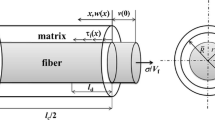Abstract
The Fatigue Damage Map (FDM) has been used to define the different damage mechanisms operating during fatigue loading of fibre reinforced metal matrix composites (MMCs). Matrix cracking, fibre failure, fibre bridging and interfacial debonding have been suggested as being the dominant factors in fatigue crack growth of MMCs. The FDM has been used to provide information regarding the contribution of these mechanisms to fatigue failure and their dependency on load history. The application of FDM is shown not only to define design limits but also to provide vital information for maintenance engineering. Fatigue, MMCs, fatigue damage map, crack safe conditions, fail safe conditions, crack arrest, crack instability, maximum bridging, micromechanical modelling.
Similar content being viewed by others
References
Johnson, W.S. (1987). Fatigue damage accumulation in various metal matrix composites, NASA Technical Memorandum 89116, Langley.
Rodopoulos, C.A. (1996). Fatigue studies under constant and variable amplitude loading in MMCs, Ph.D Thesis, Sheffield University.
Rodopoulos, C.A. (1997). Fatigue damage map for metal matrix composites–A useful tool for design against fatigue In:Proceedings of 1st Hellenic Conference of Composite Materials(edited by S.A. Paipetis and E.E. Gdoutos), Kyriakidis Bros Publishers, 545–569.
de los Rios, E.R., Rodopoulos, C.A. and Yates, J.R. (1996). Modelling the conditions for fatigue failure in metal matrix composites, Fatigue Fracture of Engineering Materials and Structures 19(9), 1093–1105.
de los Rios, E.R., Rodopoulos, C.A. and Yates, J.R. (1997). Damage tolerant fatigue design in metal matrix composites. International Journal of Fatigue 19(5), 379–387.
Yang, C.J., Jeng, S.M. and Yang, J.-M. (1990). Interfacial properties measurement for SiC fibre-reinforced titanium alloy composites. Scripta Metallurgica et Materialia 24, 469–474.
Mackin, T.J., Warren, P.D. and Evans, A.G. (1992). Effects of fiber roughness on interface sliding in composites, Acta Metall. Mater. 40, 1251–1257.
Clyne, T.W. and Withers, P.J. (1993). An Introduction to Metal Matrix Composites, Cambridge Solid State Science Series, Cambridge University Press, Cambridge.
Yang, J.M., Jeng, S.M. and Yang, C.J. (1991). Fracture mechanisms of fibre-reinforced titanium alloy matrix composites–Part I: Interfacial behaviour, Material Sciences Engineering A138, 155–167.
de los Rios, E.R., Rodopoulos, C.A. and Yates, J.R. (1996). A model to predict the fatigue life of fibrereinforced titanium matrix composites under constant amplitude loading, Fatigue Fract. Engng. Mater. Struct. 19(5), 539–550.
Davidson, D.L. (1992) The micromechanics of fatigue crack growth at 25 _C in Ti-6Al-4V reinforced with SCS-6 fibers, Metall. Trans. 23A, 865–879.
Tada, H., Paris, P.C. and Irwin, G.R. (1985). The Stress Analysis of Crack Handbook, Del Research, St. Louis, MO, 2nd edition.
de los Rios, E.R., Rodopoulos, C.A. and Yates, J.R. (1998). The fatigue behaviour of metalmatrix composites under single overloads. Fatigue Fracture of Engineering Materials and Structures 21, 1503–1511.
Ghosn, L., Kantzos, P. and Telesman, J. (1990). Modeling of crack bridging in a unidirectional metal matrix composite, NASA Technical Memorandum 104355, Langley.
Marshall, D.B., Cox, B.N. and Evans, A.G. (1985). The mechanics of matrix cracking in brittle-matrix fiber composites. Acta Metallurgica 33, 2013–2021.
McCartney, L.N. (1987). Mechanics of matrix cracking in brittle-matrix fibre-reinforced composites. Proceedings of the Royal Society of London A409, 329–350.
de los Rios, E.R., Rodopoulos, C.A. and Yates, J.R. (1995). The effect of fibre, matrix mechanical properties on the fatigue crack propagation in a fibre-reinforced titanium matrix composite, In: Proceedings of High Technology Composites in Modern Applications(edited by S.A. Paipetis and A.G. Youtsos), University of Patras-Applied Mechanics Laboratory, 316–327.
Author information
Authors and Affiliations
Rights and permissions
About this article
Cite this article
de los Rios, E., Rodopoulos, C. & Yates, J. A theoretical study of fatigue behaviour in unidirectional Ti-based metal matrix composites. International Journal of Fracture 101, 385–395 (2000). https://doi.org/10.1023/A:1007601121303
Issue Date:
DOI: https://doi.org/10.1023/A:1007601121303




